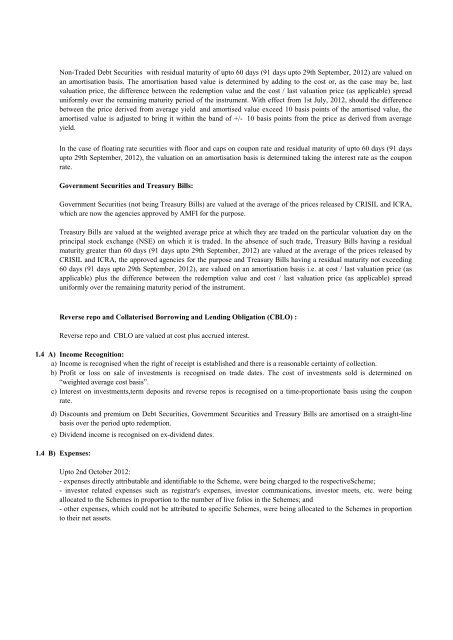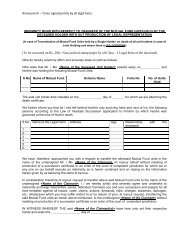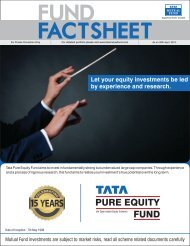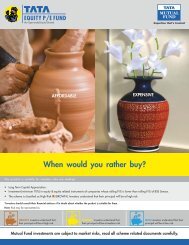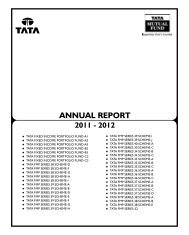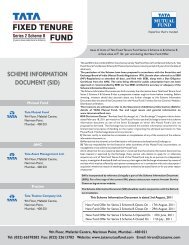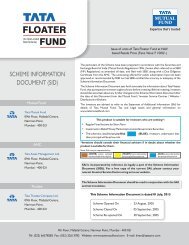Annual Report for Monthly Income Schemes - Tata Mutual Fund
Annual Report for Monthly Income Schemes - Tata Mutual Fund
Annual Report for Monthly Income Schemes - Tata Mutual Fund
Create successful ePaper yourself
Turn your PDF publications into a flip-book with our unique Google optimized e-Paper software.
Non-Traded Debt Securities with residual maturity of upto 60 days (91 days upto 29th September, 2012) are valued onan amortisation basis. The amortisation based value is determined by adding to the cost or, as the case may be, lastvaluation price, the difference between the redemption value and the cost / last valuation price (as applicable) spreaduni<strong>for</strong>mly over the remaining maturity period of the instrument. With effect from 1st July, 2012, should the differencebetween the price derived from average yield and amortised value exceed 10 basis points of the amortised value, theamortised value is adjusted to bring it within the band of +/- 10 basis points from the price as derived from averageyield.In the case of floating rate securities with floor and caps on coupon rate and residual maturity of upto 60 days (91 daysupto 29th September, 2012), the valuation on an amortisation basis is determined taking the interest rate as the couponrate.Government Securities and Treasury Bills:Government Securities (not being Treasury Bills) are valued at the average of the prices released by CRISIL and ICRA,which are now the agencies approved by AMFI <strong>for</strong> the purpose.Treasury Bills are valued at the weighted average price at which they are traded on the particular valuation day on theprincipal stock exchange (NSE) on which it is traded. In the absence of such trade, Treasury Bills having a residualmaturity greater than 60 days (91 days upto 29th September, 2012) are valued at the average of the prices released byCRISIL and ICRA, the approved agencies <strong>for</strong> the purpose and Treasury Bills having a residual maturity not exceeding60 days (91 days upto 29th September, 2012), are valued on an amortisation basis i.e. at cost / last valuation price (asapplicable) plus the difference between the redemption value and cost / last valuation price (as applicable) spreaduni<strong>for</strong>mly over the remaining maturity period of the instrument.Reverse repo and Collaterised Borrowing and Lending Obligation (CBLO) :Reverse repo and CBLO are valued at cost plus accrued interest.1.4 A) <strong>Income</strong> Recognition:a) <strong>Income</strong> is recognised when the right of receipt is established and there is a reasonable certainty of collection.b) Profit or loss on sale of investments is recognised on trade dates. The cost of investments sold is determined on“weighted average cost basis”.c) Interest on investments,term deposits and reverse repos is recognised on a time-proportionate basis using the couponrate.d) Discounts and premium on Debt Securities, Government Securities and Treasury Bills are amortised on a straight-linebasis over the period upto redemption.e) Dividend income is recognised on ex-dividend dates.1.4 B) Expenses:Upto 2nd October 2012:- expenses directly attributable and identifiable to the Scheme, were being charged to the respectiveScheme;- investor related expenses such as registrar's expenses, investor communications, investor meets, etc. were beingallocated to the <strong>Schemes</strong> in proportion to the number of live folios in the <strong>Schemes</strong>; and- other expenses, which could not be attributed to specific <strong>Schemes</strong>, were being allocated to the <strong>Schemes</strong> in proportionto their net assets.


